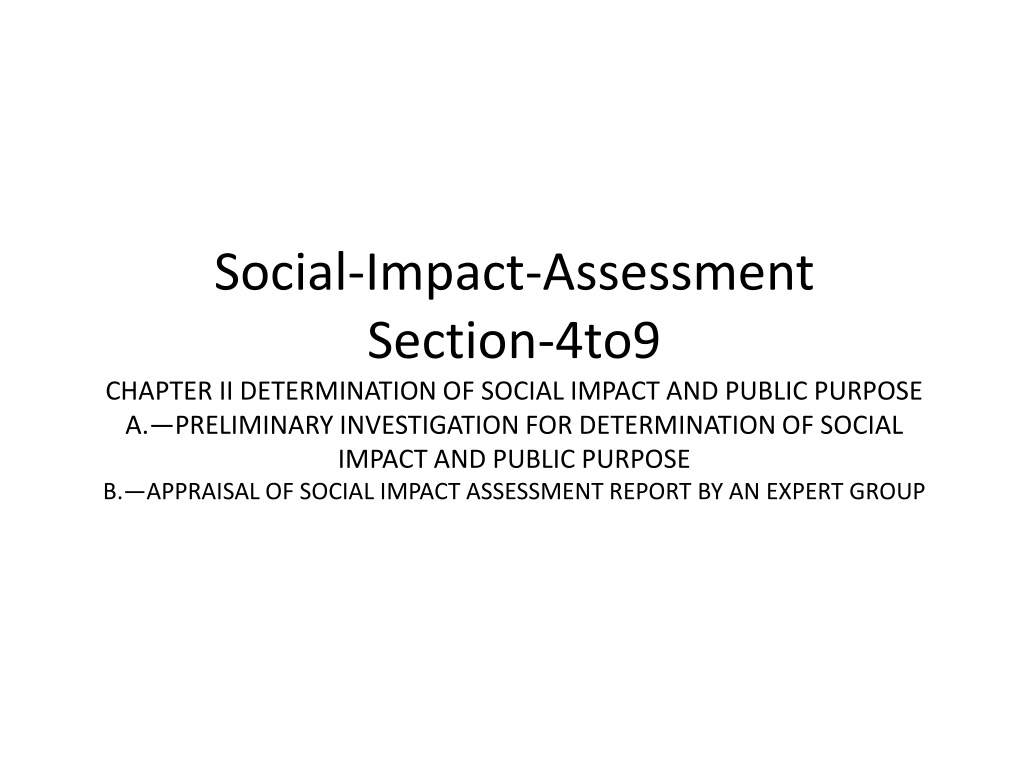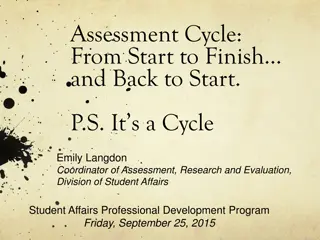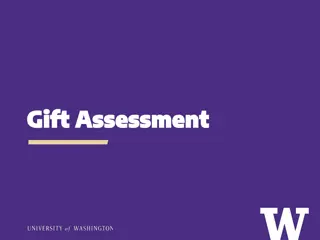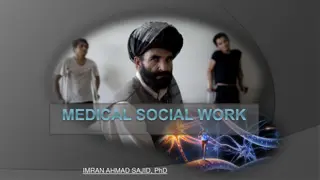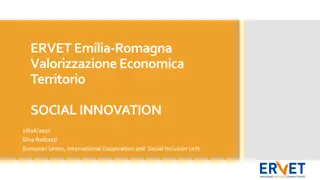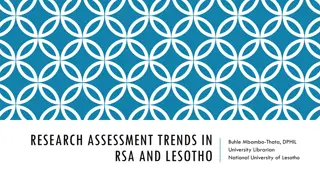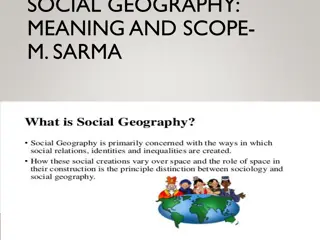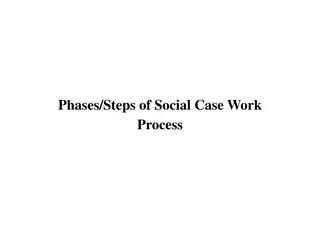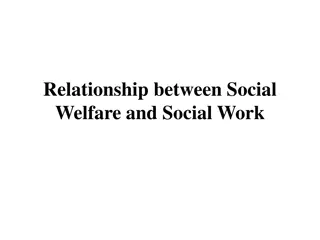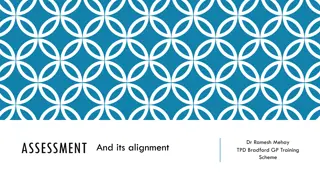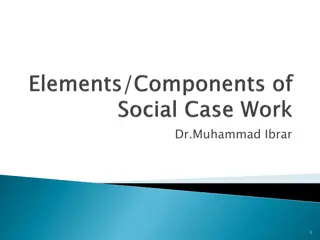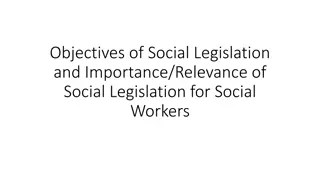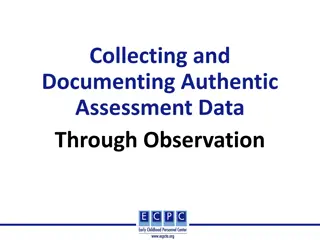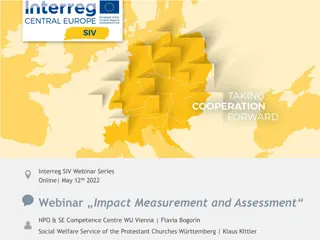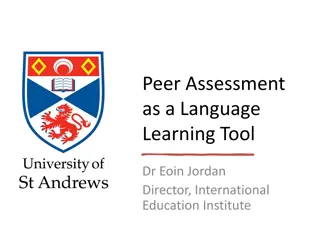Understanding Social Impact Assessment Process
Social Impact Assessment (SIA) is a crucial process that analyzes, monitors, and manages the social consequences of developments to assess their effects on quality of life and wellbeing. It aims to identify both positive and negative impacts, involving individuals, groups, and communities in decision-making. SIA considers impacts at micro, meso, and macro levels, ensuring informed and participatory development interventions. National policies like the Resettlement & Rehabilitation Policy address the rights and wellbeing of individuals affected by development projects.
- Social Impact Assessment
- Development Interventions
- Stakeholder Engagement
- Resettlement & Rehabilitation
- Public Purpose
Download Presentation

Please find below an Image/Link to download the presentation.
The content on the website is provided AS IS for your information and personal use only. It may not be sold, licensed, or shared on other websites without obtaining consent from the author. Download presentation by click this link. If you encounter any issues during the download, it is possible that the publisher has removed the file from their server.
E N D
Presentation Transcript
Social-Impact-Assessment Section-4to9 CHAPTER II DETERMINATION OF SOCIAL IMPACT AND PUBLIC PURPOSE A. PRELIMINARY INVESTIGATION FOR DETERMINATION OF SOCIAL IMPACT AND PUBLIC PURPOSE B. APPRAISAL OF SOCIAL IMPACT ASSESSMENT REPORT BY AN EXPERT GROUP
There is no universal definition of Social Impact Assessment (SIA); perhaps the best is that provided by Vanclay (2003): ...the process of analysing, monitoring and managing the social consequences of development. described as a process that seeks to assess whether a proposed development will alter quality of life and sense of wellbeing, and how well individuals, groups and communities adapt to the changes (Vanclay, 1999; 2002, 2004; Becker and Vanclay, 2003; Burdge, 2004). Social impacts are the impacts of developmental interventions on human environment. The impacts of development interventions take different forms. While significant benefits flow in from different development actions, there is also a need to identify and evaluate the negative externalities associated with them. A balanced development planning takes into account the environmental, social and biodiversity impacts of economic development. These impact assessments help in identifying the likely positive and negative impacts of proposed policy actions, likely trade-offs and synergies, and thus facilitate informed decision-making. Alternatively, SIA could be
Social Impact Assessment (SIA) is a process that provides a framework for prioritizing, gathering, analyzing, and incorporating social infor mation participation into the design and delivery of developmental interventions. It ensures that development interventions are: Informed and take into account the key relevant social issues Incorporate a participation strategy for involving a wide range of stakeholders. At the micro-level SIA impacts on individuals. At the meso-level SIA impacts on collectives, e.g. groups of people, institutions, and organizations. At Macro-level SIA impacts on social macro-systems, e.g. national and international political and legal systems. Stages in Social Impact Assessment Describe the relevant human environment/ area of influence and baseline conditions Develop an effective public plan to involve all potentially affected members of the public Describe the proposed action or policy change and reasonable alternatives Scoping to identify the full range of probable social impacts Screening to determine the boundaries of the SIA Predicting Responses to Impacts Develop Monitoring Plan & Mitigation Measures and
Ideally the SIA should an Integral part of other assessments as shown below
National Resettlement & Rehabilitation Policy 2007 (Gazette Notify: F.No.26011/412007-LRD) Infrastructure sector projects often require the exercise of legal powers by the state under the principle of eminent domain for acquisition of private property. This can lead to involuntary displacement of people, depriving them of their land, livelihood and shelter and these have traumatic, psychological and socio-cultural consequences on the affected population which call for protecting their rights. The National Resettlement & Rehabilitation Policy provides for the rehabilitation and resettlement of persons affected by the acquisition of land for projects of public purpose or involuntary displacement due to any other reason, and for matters connected therewith or incidental thereto. The Policy extends to whole of India except J&K. The Policy recognizes R&R issues formulated with the active participation of the affected persons with benefits beyond monetary compensation. It also recognizes the plight of those who do not have legal or recognized rights over the land on which they are critically dependent for their subsistence. The adverse impact on affected families - economic, environmental, social and cultural- needs to be assessed in a participatory and transparent manner. Government should inter alia, as stipulated by the policy, take into consideration the alternatives that will:
Minimise the displacement of people due to the acquisition of land for the project Minimise the total area of land to be acquired for the project, and Minimise the acquisition of agricultural land for non-agricultural use in the project. The options assessment may be in terms of the alternative project plans, potentially suitable sites, technological choices combination of these. mechanism should (as stipulated by the policy) be developed and adopted for carrying out the task in a transparent manner. available, or a Suitable institutional
Social Impact Assessment of Projects The appropriate Government shall ensure that a social impact assessment study (SIA) is carried out whenever it is desired to undertake a new project or the expansion of an existing project that will involve involuntary displacement of four hundred or more families en masse in plain areas, or two hundred or more families en masse in tribal or hilly areas, DDBs (Desert Development Blocks) or areas mentioned in the Fifth Schedule or Sixth Schedule to the Constitution. The SIA must be carried out in the proposed affected areas taking into consideration the impact that the project will have on public and community properties, assets and infrastructure. In particular: roads, public transport, drainage, sanitation, sources of drinking water, sources of water for cattle, community ponds, grazing land, plantations, public utilities, such as post offices, fair price shops, food storage godowns, electricity supply, health care facilities, schools and educational or training facilities, places of worship, land for traditional tribal institutions, burial and cremation grounds.
Subsequently, the SIA should describe all required infrastructural facilities resettlement area, specify clear timeframes within which the implementation package shall be accomplished and lay down an effective monitoring and mechanism. Where both EIA and SIA are required, the public hearing carried out in the project affected area for EIA shall also cover issues related to SIA. The SIA report shall be examined by an independent multi-disciplinary expert group with two non-official social science and rehabilitation experts. The SIA clearance shall be accorded as per the procedure and within the time limits. and amenities in the of the rehabilitation grievance redressal
Authorities for Rehabilitation and Resettlements The State Government appoints an Administrator to be not below the rank of District Collector. The responsibilities involve minimizing displacement and identifying non-displacing or least-displacing alternatives, hold consultation with the affected families, prepare a draft scheme for rehabilitation and resettlement (R&R) and budget for R&R activities in consultation with representatives of the affected families and arrange and allot adequate land for R&R also sanction benefits
Schemes Resettlements The Government declares the affected area and publishes in at least three daily newspapers, undertakes a baseline establish initial conditions against which the effects of a finished project can be compared and a census to identify members resident/carrying on trade, families losing trade, livelihood, etc., SC/ST families, vulnerable persons, etc. Within 90 days, the Government must publish survey results and call for objections, submit report within 30 days and then the Government should finalize survey within 45 days thereafter. and Plans for Rehabilitation and survey designed to
The Administrator for Rehabilitation and Resettlements (R&R) shall prepare a draft R&R scheme or plan for affected families after consultation with the representatives of the affected families including women and final publication of plans and schemes. A R&R scheme or plan would contain the following: Social assessment Consultation and participation process Documentation of voluntary nature of contributions Census and baseline socio-economic surveys Cut-off date Co-ordination between Stakeholders Civil works, resettlement etc. Screening and planning Implementation Institutional arrangements Overall Co-ordination Transparency and accountability Costs and Budgets Grievance Redressal Monitoring and Evaluation including social, financial and environmental audits indicators
Rehabilitation and Resettlement of Affected families The Government declares resettlement areas, encourage affected families to settle in groups, purchase or exchange of land, allocate funds for rehabilitation and resettlement, compensate, and provide infrastructural facilities and amenities and local self-government Institutions in resettlement areas. There are special provisions in case of urgency and periphery development. Rehabilitation and Resettlement Benefits for Affected families This includes housing benefits, allotment of agricultural land, registration of land or other property allotted. Financial assistance for cattle shed, transportation cost, working shed or shop employment and skill development. Rehabilitation grant and option for allotment of shares, land development projects, fishing rights, subsistence allowance, monthly pension to vulnerable affected persons, option for a lump-sum payment in lieu of benefits, special provisions for Scheduled Tribes and the Scheduled Castes.
Grievance redressal The policy mechanism including a standing R&R Committees at the district and project level. These committees shall have representatives from the affected families including women, voluntary organizations, local elected representatives, etc. Social audits of the rehabilitation and resettlement schemes and plans should be undertaken. Social audit is a way of increasing community participation, strengthening links with providers, promoting accountability, and instilling a sense of responsibility among all those involved. It is a process by which the people (the final beneficiaries of any scheme, programme, policy or law), are empowered to audit such schemes, programmes, policies and laws. provides for a strong grievance redressal government transparency and/or and service public
A social audit involves both the service providers and the users examining the impact of the project or service in a systematic way comparing the real benefits that have accrued with the expected benefits, while also looking at unexpected impacts. It is an ongoing process (in-fact environment audit should be an ongoing process starting from the designing phase to monitoring phase) by which the potential beneficiaries and other stakeholders of an activity or project are involved from the planning to the monitoring and evaluation of that activity or project. It thereby tries to ensure that the activity or project is designed and implemented in a manner that is most suited for the prevailing local conditions, priorities and preferences of those affected by it, and most effectively serves public interest. The findings of the social audit are shared with all stakeholders and where problems are identified, the process for implementing changes is initiated. social, financial and appropriately reflects the
